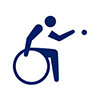 a Summer Games Paralympic Sport
a Summer Games Paralympic SportGoverning Bodies
International Governing Bodies

Boccia International Sports Federation (BISFed)
National Governing Bodies
United States

USA Boccia
Introduction:
Boccia is a precision ball sport, similar to bocce, and related to bowls and pétanque. The sport is contested at local, national and international levels, by athletes with severe physical disabilities. It is one of only two Paralympic sports (along with goalball) that have no counterpart in the Olympic program.
History of the Sport:
The name of the sport, boccia, has been disputed whether it derives from the Italian word for ‘ball” or the Latin word for “boss”, but it is agreed that it was originally developed for people with cerebral palsy and has grown to includes athletes with other severe disabilities that affect their motor skills.
The sport has been long played for fun and first appeared at the Paralympic Games in 1984. Since then it has expanded and is now played by athletes in 75 countries all over the world.
Rules – How to Play the Sport:
Boccia can be played by individuals, pairs, or teams of three. All events are mixed gender. The aim of the game is to throw leather balls — colored red or blue (which side uses which is determined by a coin toss) as close as they can to a white target ball, or jack. The jack is thrown first, then the first two regular balls are played (first, the player who threw the jack then the opposing side), after which the side furthest away from the jack goes next in an attempt to either get closer to the jack or knock the opposition’s ball out of the way. In this fashion, each round, or end, will continue until one side has played all their balls, at which point, the opposing side will play their remaining balls. The balls can be moved with hands, feet, or, if the competitor’s disability is severe, with an assistive device such as a ramp. At the end of each end, the referee measures the distance of the balls closest to the jack, and awards points accordingly — one point for each ball that is closer to the jack than the opponent’s closest ball. The team/player with the highest number of points at the end of play is the winner. If both teams have the same number of points after all ends have been played, one additional end is played to determine a winner.
The number of ends and balls in each end depends on the side makeup. Individual competition consists of four ends and six balls per player per end, whilst paired competition is four ends and six balls per pair per end (three per player). Team competition is six ends, and six balls per team per end (two per player).
In pair and team events, a reserve player is allowed. Between ends a reserve can be substituted for a player during a game, but only one substitution per game is permitted.[3]
Boccia is played on a court measuring 12.5 m × 6 m (41 ft. × 20 ft.) with 2 m (6.6 ft.) of empty, in-bounds, playable space around it. The surface of the court is flat and smooth—typically a converted wooden basketball and/or volleyball court but sometimes a hard turf surface flooring. The throwing area is divided into six rectangular throwing boxes in which the athletes must stay completely within during play. On the court is a V-shaped line over which the jack must cross for the throw to be valid. At the end of the court is the ‘dead ball container’ in which balls are put if they are thrown outside the time limit, out of the area of play or if the athlete violates a rule during his or her throw. A cross marks the position where the jack must be placed if it touches or crosses the boundary line or in the case of a tie-break. The balls themselves are made of leather and are slightly larger than a tennis ball, weighing approximately 275 grams (9.7 ounces) and measuring around 270 mm (11 inches) in circumference (about 86mm diameter). They are available in different grades of softness and hardness and are selected purposefully to execute desired strategies within a match.




